

507. $40
Seth Thomas “Banjo No. 8”, 1933. This is a 29-inch banjo with a mahogany case; it may instead
be the “Crandall” or “Banjo No. 7”, both of which are the same dimensions and have the same #120 round pendulum movement. The
glasses are interesting here; both are silhouettes, I believe of George Washington and Mount Vernon, against a solid painted background. They are not shown in Ly’s books on Seth Thomas clocks, but ST did use some silhouette panels in select clocks during this period
(see “Special No. 26” in Ly’s Vol. 1). The silvered dial is in good shape behind a beveled convex glass, with two brass sidearms
and a brass eagle finial. The hands are ST issue. There is a veneer chip on top of the clock where the finial got knocked
off. It is not visible from the front. The back-plate appears to be a replacement. We can’t keep this clock running
for more than a few minutes. $60-$125.
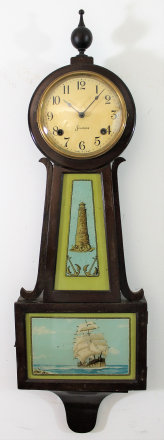
508. $60
Sessions “Revere” banjo, ca. 1927. A 35.5-inch banjo in a mahogany-finished case, with some
wear to the finish; wax would fix. The glasses are as shown in the catalog photo (see Ly, Sessions Clocks). The iveroid
dial is good behind a convex glass, hands appropriate, finial correct. The 8-day signed pendulum movement is running, striking
on a cathedral gong on the hours and half-hours. $60-$125.
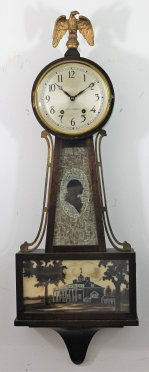
509. $60
Seth Thomas “Banjo No. 2”, ca. 1928. A 29-inch mahogany-cased banjo with a silver dial and correct
hands, beveled convex glass, two reverse-painted glasses, brass side-rails and a gilded eagle finial. The 8-day #125 lever movement
strikes the hours and half-hours on a vertical rod. It is running and striking appropriately. $60-$150.
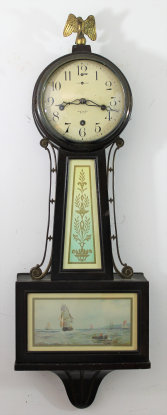
510. $75
New Haven “Whitney”, ca. 1932. This is an unusual banjo in that it plays Westminster chimes
on four rods. The case is in a mahogany finish, 30-inches long, with two correct panel designs behind the glasses. The dial is cream-colored behind a convex glass, the hands, side-arms and eagle finial are correct. A scrape on the right throat
frame has been stained to match. The clock is ticking but the chimes are not functioning and will need some sort of adjustment;
they try to strike on the quarter hours. A small label on the back, but no instructions for use. $75-$150.
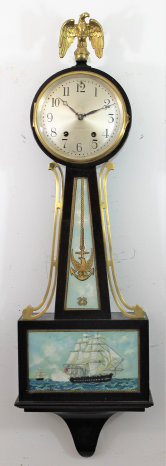
511. $150
Seth Thomas “Eclipse”, ca. 1880. The Eclipse, or “Ball-top” is shown in Vol. 2
of Ly’s book on Seth Thomas clocks, page 724. This one is in walnut, likely original finish, with an old decorated glass, a
signed paper dial, proper hands and an Eclipse pendulum bob. There is a label inside and a push-button door lock. The
clock is running and striking; the alarm was not tested. A nice example, 24 inches high. $150-$200.

512. $2500
English astronomical regulator, ca. 1830. A number of English clockmakers made astronomical
regulators beginning in the early 1800’s in a variety of styles. This clock is typical of the time-only style, with an engraved,
silvered brass face holding three separate dials: a minute chapter ring, a 12-hour lower dial, and a seconds dial on top. Each dial has one hand. The clock face was often signed, but not here, so we do not know who made it. The movement has
heavy front and back brass plates with side plates, five large pillars fastened with screws between the plates and dial, large 6-spoke
wheels with capped pivots front and back, a dead-beat escapement and pallets with jeweled faces, all features typical of this style
of clock. There is a centering adjustment for the pendulum anchor; the pendulum hangs from a separate mount on the
back of the case and is also adjustable left-to-right. The pendulum weight is a heavy glass jar containing mercury, held in
a decorative cradle on a steel rod. The single silver-plated weight is suspended on a silvered, spoked pully and needs replating
or replacement. The loss of finish to the weight is the only real flaw to this clock, although the face could stand to be resilvered. The 90-inch case is pine with a high-quality figured mahogany veneer all around, including inside on the visible back wall. There is a gothic window in the door that is repeated in form in the bonnet, with three pyramid steeples on top and the center steeple
sitting on mahogany block. The front corners are chamfered and the base is scrolled and veneered. There are no noticeable
losses, scratches, or bruises to the case and it all appears original, including the glasses. There are a number of penciled
inscriptions on the back, the earliest I see is dated 1841, and later 1899. The clock is running easily and keeping accurate
time. Similar clocks have sold in the last decade for from $4000 to $17,500 at R.O. Schmitt, Fontaine’s, and Harris. $4000-$10,000.
We can deliver east of the Rockies, <350 mi – $175, >350 mi – $325.
Side view Dials Base Movement-1 Movement-2 Weight Pendulum
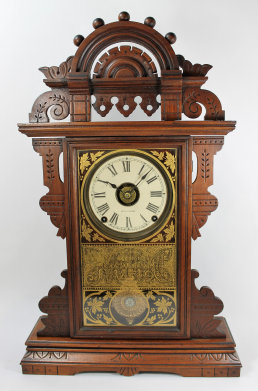
513. $50
Chauncey Jerome cottage, 1845-1855. Jerome made a number of cottage clocks in this style
with a reverse-painted glass door, signed at the bottom “C Jerome | New Haven”, in a rosewood-veneered case. The upper sides
and top are grain-painted to match and save on veneer costs. There is some loss to the backing on this silver scroll design
with green vine leaves at the corners. Many of these clocks had wooden dial boards and I am not convinced that this old painted
metal dial, or the matched small unsigned brass time-and-alarm 30-hr movement are original to the clock, based on screw holes in the
dial mounting strips. The hands are appropriate replacements. There is no label inside, but parts of an illegible label
are protected by plastic on the back. The clock is running, we didn’t test the alarm. $50-$100.
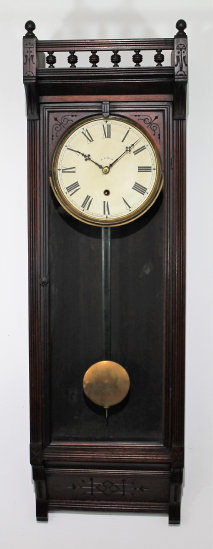
514. $300
E.N. Welch “Owasco”, ca. 1890. This is a Welch clock that is not found in Ly’s book on
Welch clocks. It is 37 inches in length in black walnut with an old dark finish. There are inscribed designs on the door
dial surround, the corners of the crest, and the base. The signed dial is old paper, the brass bob could use some polish, the
pendulum stick original. The 8-day brass spring-driven movement is signed, time-only (perfect for a bedroom) and running strongly. There is a good label identifying the maker and model on the back. An uncommon clock; there are no listings in the Antique Clocks
Price Guide and I do not see that we have sold one in the last 5 years. $300-$600.
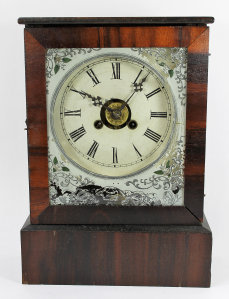
515. $900
Waltham banjo, ca. 1930. A weight-driven banjo in a 41-inch mahogany case with the original
hand-painted glass panels (very nice) and an old painted metal dial. The weight shield and pully-suspended lead weight are replacements;
everything else appears original. The brass sidearms and bezel could stand to be polished. The 8-day signed brass plate
movement is running easily and keeping time. These typically sell for around $1000.
Interior Movement Pendulum bob
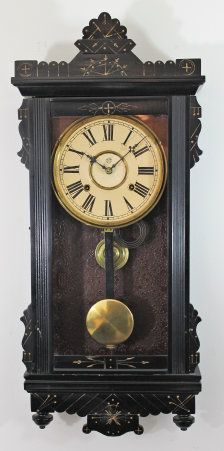
516. $50
Ansonia “Dispatch”, ca. 1883. A 30-inch black lacquer case with incised gold trim, shown
on page 177 of Ly’s book on Ansonia clocks. An 8-inch signed paper dial, replacement hands, pendulum bob looks newer. The front glass should be decorated, two finials are missing at the top, and the top-most and bottom-most pieces of trim have been
broken off and reglued. Ok, so it’s not perfect. The signed Ansonia 8-day spring-driven movement is running and striking
on a cathedral gong with a nice sound. The interior backboard appears to have been modified with an applied painted lace doily. No label inside or out. Key included. $50-$100.
